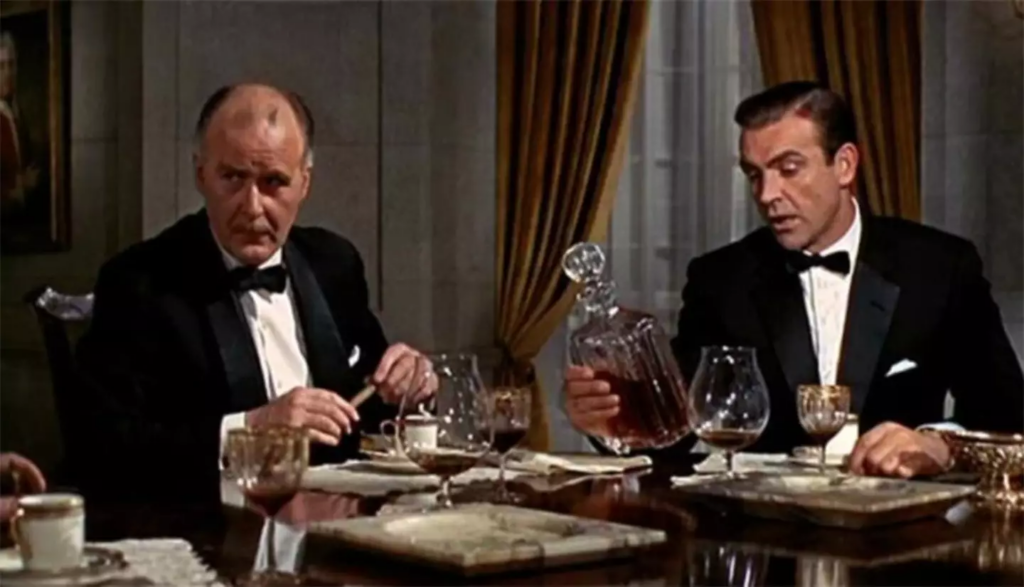It’s always fun to look back and see how different life was in generations past. How far technology has come, differences in fashion, and how we prepare and present food have changed (we’re looking at you, Jeremy Allen White). But one thing especially noteworthy is how films have changed in the last few decades, specifically the James Bond movies.
Now, we don’t actually mean the films themselves, but rather what a particular one from days gone by shows us. The film in question? 1964’s Goldfinger.1
The film pits a young Sean Connery against the eccentric, gold-smuggling (aptly named) Goldfinger. But while it’s a classic Bond film, we’re more interested in the brief cameo actor Richard Vernon has as Colonel Smithers. The image below shows Smithers next to a 34-year-old James Bond; any guess how old he might be?

He’s 39- Only five years separate the two actors in this shot.
The case for faster aging in general was further examined when former baseball pitcher Brandon McCarthy asked: Did people in the past look older when they were younger? The simple question has led to a flood of old photographs resurfacing, showing people looking remarkably mature for their age.

Read More: 7 Science-Backed Lifestyle Tweaks to Improve Your Memory That Actually Work
Youthful Looks From Days Past
The initial tweet triggered a collective journey through time, with users sharing snapshots that completely defied today’s perceptions of age. Among the examples was a balding man, reminiscent of George W. Bush, purportedly at the tender age of 23. Another image depicted a woman in her 40s sporting a hairstyle now associated with the elderly. Such anomalies prompted a deeper exploration into the factors influencing our perceptions of age across different generations.2
When comparing fashion and grooming to yesteryear, a compelling aspect of the age perception paradox comes to light. Hairstyles and clothing from past decades often convey a sense of greater maturity than today, reflecting the difference in trends and societal norms. As styles evolved, certain aesthetics became associated with older generations despite their actual age at the time. Hairstylist Gwenda Harmon notes how hairstyles of days past gave an air of sophistication, contributing to the illusion of advanced age.
Moreover, the association between outdated fashion and aging is even more apparent in historical photographs. A poignant example is found in Dale Irby, a physical education teacher who maintained a consistent wardrobe across four decades. His choice of attire, emblematic of the 1970s, accentuates the perceived age progression captured in successive school portraits.

Other Reasons for Our Youthfulness
Beyond superficial impressions lies a nuanced understanding of aging dynamics shaped by both biological and environmental factors. Cigarette smoking, much more prominent in society 50 years ago, cast a shadow over skin health, leading to premature aging marked by wrinkles and discoloration. However, societal shifts and public health initiatives have significantly reduced smoking rates, mitigating the aging effects associated with this habit.
Similarly, advancements in skin care, coupled with increased awareness of sun exposure, have reshaped age-related perceptions. The use of sunscreen and skincare interventions has shielded us contemporary folk from the ravages of UV radiation, preserving a much more youthful appearance over time.
Bridging Past and Present
As research further explores the interplay of biological and sociocultural factors regarding age perception, it’s important to address the fundamental shift in societal norms. While past generations bore the physical toll of laborious work and prevalent smoking habits, our lives today prioritize health and longevity. From improved nutrition to innovative cosmetic interventions, the modern era is much more interested in eternal youth.
The flood of historical photographs shows a profound divergence between past and present perceptions of age. While societal shifts and lifestyle advancements have propelled us towards a youth-centric society, the literal relics of the past serve as reminders of the multifaceted nature of aging.3
Read More: Dancing Can Reverse the Signs of Aging in the Brain – Here’s How
Sources
- https://www.unilad.com/celebrity/39-year-old-man-james-bond-richard-vernon-goldfinger-age-070661-20240315
- “We Used to Look Older.” McGill. Jonathan Jarry M.Sc. October 20, 2023.
- “Why Did People “Look Older” In The Past?” IFL Science. James Felton.
July 13, 2022

